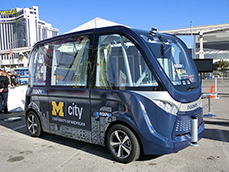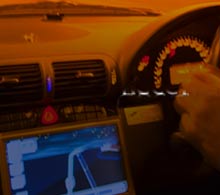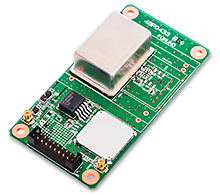Articles for ITS market Fusion of ride sharing and fully automated driving is advancing in the USA.
Autonomous vehicles are what we should pay attention to looking at ride sharing
CES (Consumer Electronics Show), the world's largest show for IT and consumer electronics, was held in Las Vegas, USA in early January this year.
Literally, here is a place where global manufacturers exhibit the latest products related to IT and electric machinery. Among them, the presence of automobiles is increasing recently. One Japanese television news program reported that "There is an atmosphere like a motor show".
From the United States, Ford and FCA (Fiat / Chrysler / Automobiles) participated. Daimler and Volkswagen from Europe, Hyundai and Kia from Korea did as well. From Japan, the largest companies such as Toyota, Nissan and Honda gathered together. In addition, major automobile parts manufacturers, Denso, Hitachi Automotive, American Delphi, France Valeo and others also exhibited.
Automated Driving was the core exhibit of each manufacturer, but the exhibitions focus on the ride sharing was also conspicuous.
Automated driving and ride sharing are very involved with both the US government and private companies
The US government is currently proactively promoting legislation for the automated driving.
In September 2016, the Department of Transportation's Road Traffic Safety Administration (NHTSA) announced guidelines on the automated driving. Also, in December of the same year, they announced rules on so-called connected cars such as a communication between “cars and cars" and "cars and infrastructure (road equipment)". Japan and European countries are advancing the consultation for legislation of an automated driving and a connected car in the United Nations, but the United States seems to push through their own way and aim to make it become as the world de facto standard.
Since automated driving is naturally a connected car, these two legal arrangements are deeply involved. Furthermore, collaboration between major IT vendors and some automobile manufacturers are affecting some of the moves behind the US government actions.
In April 2016, Alphabet, a Google's parent company, Ford, Volvo, and ride sharing giant Uber and Lyft established a consortium aiming at lobbying for the spread of ride sharing by automated driving. Ride sharing is called "white taxi” in Japan and the meaning is illegal passenger transportation by individual owned car. In the US, it is a new automobile related business that has grown rapidly since the beginning of the 2010s.
Based on the consortium of the above five companies, Ford announced in August 2016 that Ford will put fully automated driving into practical use by 2021. Volvo, in partnership with Uober, announced that it will begin a demonstration test of fully automatic operation in Volvo's local Sweden from 2017.
Thus, in 2016, the movement of full-scale mass production of automated driving accelerated involving US government and private enterprises and the ride sharing will definitely be involved as well.
Waymo, a Google affiliated company will be joining to fully automated driving business
 A press conference Waymo did at the North American International Auto Show (Detroit Show).
A press conference Waymo did at the North American International Auto Show (Detroit Show).
 FCA (Fiat / Chrysler / Automobile) also showed automated driving car with ride sharing included.
FCA (Fiat / Chrysler / Automobile) also showed automated driving car with ride sharing included.
In such a huge trend of the US automated driving business, who is at the center? It is still Google. Why? Firstly, they have Google maps and Google Earth. Secondly, a cloud service that connects directly with Gmail. Thirdly, they have been continuing huge investment to fully automated driving project since 2009. Because of these reasons, Google and its parent company, Alphabet, are in a position to be able to become a bridge between the IT industry and the automobile industry.
The Alphabet’s automated driving division has been separated and independent from Alphabet in December 2016. "Waymo" is the name of this new company.
Alphabet has tested millions of kilometers on public roads by "Google cars" and has accumulated vast amounts of data. In addition, they have independently developed various sensors to use in the automated driving. They will start a business that utilizes the assets of these technologies.
Waymo has already announced a technical alliance with FCA (Fiat-Chrysler Automobile). Using a test vehicle based on Chrysler 's minivan "Pacifica", they have begun demonstration tests in the US from the end of January 2017.
Waymo has also announced that they have been considering a technical alliance with Honda. Honda unveiled the concept automobile "NewV", a fully automated driving vehicle corresponding to ride sharing at the CES Show. It is no doubt that this is an announcement for cooperation with Waymo.
It is the first time for Japanese manufacturers to clarify the development for fusion of ride sharing and fully automated driving.
2020s is time when the automobile industry changes dramatically
In the beginning of January every year, I have constantly covered the CES in Las Vegas, Nevada, and the North American International Auto Show in Detroit, Michigan (so-called Detroit show) in a row.
In recent years, many of the announcements for the next generation automobile technology that was anticipated five to ten years ahead have been carried out at CES. Meanwhile, the announcement at the Detroit show is the concept model that has been decided to be mass-produced one or two years later.
Especially this year, I strongly felt "Temperature difference to the future of automobile" between CES and Detroit show. For automotive officials who only see the Detroit show, they may be not able to imagine that automated ride sharing is so prevalent in cities throughout the United States in the next five years later, 2022. I believe that the huge trend of next generation automated driving business which is accelerating rapidly in the US will definitely come to Japan with generating critical time lag.
Writer introduction

Mr. Kenji Momota Automotive journalist
His major is the world automotive industry and he is also familiar with the energy industry, IT and the aging society problem as the related fields. He acts around the world based in Japan and USA and writes for the general magazines, the technology journals and the automotive related media etc.
He is also commentator of motor race and world's motor show on TV program based on his career of the driver of Indy Racing League and NASCAR. In recent years, he has been covering about a paradigm shift from developed countries to developing countries, the motorized vehicle like EV and the telematics.
FURUNO ITS Journal
Click here for the latest articles after 2022 (in Japanese)2022
- The "realistic" self-driving roadmap shown by the Japanese government and a hands-on report on the latest Subaru EyeSight X
- Will FCVs (Fuel Cell Vehicles) Become Popular? ~New Movement in Toyota and Honda~
- The 'Complete' online sales of new cars start in Japan. Will this new way of buying cars take root?
- Many Firsts! On-Site Report from Tokyo Auto Salon 2022 - The author, who knows what goes on behind the scenes, looks back on 40 years of history. -
2021
- "Moving toward zero traffic fatalities for four-wheeled and two-wheeled vehicles globally in 2050" ~Experience on Honda's latest safety technologies~
- Tsuneishi Shipbuilding's building and DX, an exclusive visit to the main factory
- Japan's Smart City: New Moves toward Practical Use
- When will self-driving buses (service cars) be put to "full-scale" practical use?
- Utilization vehicle data during disasters
- Toyota-led Connected Technology to Transform Commercial Vehicle Business -From light trucks to large trucks and buses-
- Toyota enters the connected car "Personalization" business
- Japanese automakers' carbon-neutral strategies swept up in ESG investment
- Drive experience of the latest autonomous vehicle models and advanced driving support systems
- Will carbon neutrality accelerate the trend to strengthen LCA (Life Cycle Assessment)?
- Semiconductor shortage exposes realities of the automotive industry
- Online Autonomous Driving Contest Enhancing development of Human Resources
2020
- What happens to CASE when gas cars are banned in Japan?
- When will Flying Cars be launched?
- Expectation vs. reality:Autonomous Driving in Japan
- V2X, Becoming increasingly important in autonomous driving
- Technology of Subaru “EyeSight X”
- Lifestyle-oriented French cars gain popularity in Japan
- Human-oriented smart cities are wanted
- MaaS and CASE, how would automotive industry change after COVID-19?
- The beginning of virtualization era, triggered by COVID-19
- Trend of EV shift and consumer demands
- TOYOTA Press conference about ADAS - Releasing algorithm for "sudden acceleration suppression during attempted sudden acceleration" free of charge -
- The Japanese automotive industry in 2020 - 3 turning points -
- "Using a smartphone while driving" and "Level 3 automated driving"
2019
- Motor show business model is at a turning point - Tokyo Motor Show Report -
- Commercialization and monetization of MaaS - ITS World Congress Singapore Report -
- Android Automotive pays attention to V2X - Report from the Frankfurt Motor Show 2019 in Germany -
- Automobile Distribution Revolution and DCM (Data Communication Module)
- Connected business potential and newly proposed "eMaaS" by Honda
- 5G services for practical use are multiplying
- Connectivity technologies attracting attention due to frequent traffic accidents
- Shanghai Motor Show report -SUV, EV, Automated car & 5G-
- Drone Business roadmap and updates to Michibiki (Quasi-Zenith Satellite System)
- MaaS (Mobility as a Service) "town development." Full-scale promotion for a national project
- CES organizer states "Data Period in 2020s." Transformation of the Automotive Industry in CES, US "-CES2019 Report-"
- "Return to Origin" directed towards the age of change, automatic operation and connectivity
2018
- New proposal for Private Car Automated Driving Level and other Hot 5G Technology Topics
- Standardized EV charging infrastructure concerns in Europe, US, Japan and China - Kobe EVS 31 field report -
- Touring a pure car carrier and a test drive of the latest hybrid car
- Planning stage products are exhibited at the newly established visualized mobility service "TOYOTA MOBILITY SHOWROOM".
- Potential “Community Car-share” program promoted by local residents
- CES Asia Report 2108
- Companies attempt new Vehicle-to-Infrastructure communications, including traffic volume measurements and vehicle positioning. -ITS Asia Pacific Forum in Fukuoka-
- Geneva show in Switzerland. Flying cars and MaaS (Mobility as a Service) were hot topics.
- EV (Electric Vehicle) proposals by country
- MaaS competition through service mobilization, M & A and technical field collaboration is accelerating. - The CES 2018 Report -
2017
- Big data’s initiative and fight for the automotive industry. Cooperation among companies becomes increasingly important.
- Connected car and road-to-vehicle communication automatic operation
- ETC (Electronic Toll Collection) and ETC2.0. Current situation and projected future
- Rapid development of sharing economy
- Germany is first to recognize level 3 automated driving
- ITS EU 2017 Field Reports -Automatic Operation and the eCall-
- From Infotainment to ITS, the competitive area is spreading in the car big data industry.
- GTC (GPU Technology Conference) Report and the de facto standardization of AI (artificial intelligence)
- Renesas' new challenge! "e-AI Solution" and "Renesas Autonomy"
- The Automobile industry is shifting from a manufacturing industry to a service industry.
- The movement toward accident countermeasures for aging drivers in Japan
- Fusion of ride sharing and fully automated driving is advancing in the USA.
2016
- Overview of the Quasi-Zenith Satellite System (QZSS) and advancements toward full-scale practical use including the Tokyo Olympic Games - G-space EXPO 2016 report-
- Japan’s automated driving project "SIP-adus" will be a large demonstration experiment.
- The International Home Care & Rehabilitation Exhibition. There were many car manufactures with exhibits booths at this show.
- Japanese car manufacturers starting to concentrate on strengthening the ADAS system
- A new movement of legislation for autonomous cars
- Cyber Security and “AGL”, the new OS for automotive are hot topics in the connected car industry
- “High precision 3D map” the key future of autonomous car and pedestrian dead reckoning
- Chinese “BAT” is accelerating their business in the EV (Electric Vehicle) market
- Tesla's original connection to Taiwan and the new transportation system technologies.
- "The main topic" of the Geneva Motor Show was how to strengthen "pedestrian protection"
- The probe data business is getting more competitive
- Reporting directly from the 2016 CES show "Data services will soon become the main revenue source of automotive industry"
2015
- Do the automated driving systems need the GNSS (Global Navigation Satellite System) ?
- ETC Version 2.0 is coming soon. A new service was announced at the Tokyo Motor Show and the possibility that is could be used as a device for older drivers.
- "Connected Horizon" and "eHorizon". Germany's leading parts supplier accelerates strengthening of "Big Data" for business



 Many parts of the CES Show were very much like a large motor show. The US EV venture, Faraday Future, attracted a large attention.
Many parts of the CES Show were very much like a large motor show. The US EV venture, Faraday Future, attracted a large attention. Outside the CES venue, Lift, a ride sharing giant company was advertising.
Outside the CES venue, Lift, a ride sharing giant company was advertising. Honda exhibited at CES for the first time in ten years, with the first of their automated driving vehicles with ride sharing
Honda exhibited at CES for the first time in ten years, with the first of their automated driving vehicles with ride sharing Below is an automatic driving compact bus that collects data at the M City, which is a facility for demonstration experiments that was opened in 2015 and is part of the University of Michigan.
Below is an automatic driving compact bus that collects data at the M City, which is a facility for demonstration experiments that was opened in 2015 and is part of the University of Michigan. GPS/GNSS Receiver&Chips and Modules (positioning and timing)
GPS/GNSS Receiver&Chips and Modules (positioning and timing)